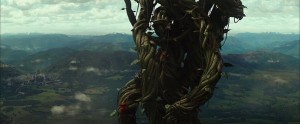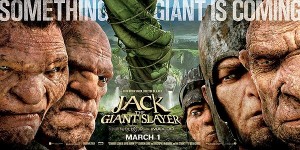Interview: John Ottman, Editor/Composer of “Jack the Giant Slayer”
Posted on February 27, 2013 at 8:00 am
 John Ottman is not just editor of this week’s exciting fantasy, “Jack the Giant Slayer” — he also composed the score. I had a lot of fun talking to this polymath about his work on the film.
John Ottman is not just editor of this week’s exciting fantasy, “Jack the Giant Slayer” — he also composed the score. I had a lot of fun talking to this polymath about his work on the film.
When you think about doing a movie set in another period and especially a fantasy movie what kind of signals can you send with the soundtrack?
Well I think the obvious thing is to be intentionally medieval or have music in line with the time or period but I didn’t do that. I just wanted to try to make the score timeless in terms of just good old fashioned movie adventures as opposed to something that is categorized into a certain time or period, doing stuff that was too fairy tale-like or obvious. I try to do that with the music as much as I could. It’s sort of a fine line between pushing the popcorn buttons but trying to keep the bar a little higher as much as possible without sacrificing popcorn fun.
Like any good popcorn movie you have romance and adventure. How do you begin to put that together in the soundtrack?
I just looked at my deadline and I panicked and something comes out of my head. But just frankly this was all about story and these are timeless themes in this movie. You have the princess that doesn’t want to be a princess. But she gets saved by a pauper and they fall in love. I mean it’s not something we haven’t seen before so the challenge was how to keep it fresh and basically take a time old story and make it interesting for people.
Well it is a time old story but as you said these are themes that are perennially appealing. What is it about the story that makes these themes so enduringly popular?
People still fall in love. So I guess a love story is something everyone can still relate to. And I guess there’s also the fantasy on the boy’s part of being a hero. And so I think those things will be true forever.
And at what point do you start working on the music? Had you seen any of the visuals and special effects? Did you have a sense of what the world was going to look like?
I’m the editor so I know everything. By the time I started writing the score I had probably seen the film hundreds of times. I was the one storyboarding the sequences and these motion capture shots and nurturing every visual effect for a year and a half. So by the time I go to write the score I am well aware of what the visuals are and it’s difficult because I have very little time to actually write and give time to my other responsibilities on the film, managing the movie.
Wow. You really surprised me. I though the music would come before the editing.
If I weren’t the editor I would have been on a maybe like a month before the editor’s cut was put together to watch the film and write the score. You have to tailor the music exactly to the images on the screen. They have to be in sync with what’s going on. You really can’t write anything ahead of time.
As you’re editing are you thinking about the music, the rhythms?
As I’m editing I’m just thinking, “I have to write all this music. I’m don’t know when I’m going to have the time.” From day one I’m tormented by the fact that I somehow have to write this score but I don’t know when I am actually going to have the time to do it. That’s what I’m thinking about. As I’m making the movie of course I’m thinking about the types of music that it’ll need but I don’t specifically write anything while I am cutting because it’s such a life encompassing job just to cut a movie together. I wish I could. I would have less to do later.
I’ll intentionally create like a pregnant area in the movie so I’ll know that’s it’s going to be a big score moment for the drama. What the score is going to be I have no idea. I know generally the kind of music it is going to be.
Tell me a little bit about some of the challenges of editing such a special effects intensive movie.
I don’t recommend it to anybody. Special effects are one thing. Motion capture is a whole ‘nother world. Because basically you are taking raw data that is not even on film or videotaped. It is just basically computer data based upon the movements of the actors and you can make anything of it you want. So I would take that data and lens the shot which is what creating the shots. It’s very complicated because from that point on I would create a shot and storyboard how the real people are going to be integrated within that shot. So then I would take the shot to set and then based upon the storyboard would dictate how much of a set they would have to build and then becomes the battle between the production designer and the visual effects team. Who’s going to help? How much stuff are they going to build? How much is going to be CGI? So it’s enough to make your head explode on a daily basis because it’s just a lot of creating something from nothing. So each one of those shots, I don’t know how many there are, over 1000, is its own separate project that you have to basically baby until it’s finished. All the way from the original lensing to creating the textures of the skin to the lighting and integrating it with the real actors.
So all the giants were motion capture?
Yes.
Wow.
Those are real people walking around in motion capture outfits. But again it’s just the general movements of the faces that are caught and the general movements of the bodies. We embellish if we have to. But the animators do it and they create all the skin textures, and the outfits, and the background and the whole bit. It’s just a massive project. Process I should say.
Disney set a very high bar for beanstalks with “Mickey and the Beanstalk” but I thought you really did an amazing job.
That’s a relief to hear because I was the number one cynic of the bean stalk. I was the non-believer because I thought it looked like a chunk of plastic all the time. I was aghast. I never thought anybody would ever buy it and it seems that in the end it worked through creative lighting and so forth on the set and then the CGI people spent a lot of time on the animation and the coloring to try as best as possible to try to make it look real.
I understand that you started making movies when you were very young. What were the movies that inspired you to want to make movies?
Well actually they weren’t movies; they were the original “Star Trek” series. It actually pretty much trained my brain how to score movies because they has to reuse a lot of their existing music. It taught me how they would reuse thematic ideas and so forth. And they scored those episodes in a very classic way. That was a huge influence on me, that series and then when “Star Trek: The Motion Picture” came out, the movie version. And of course “Star Wars.” That was the catalyst that woke all of us up inside, especially the resurrection of the classic film score.

One Reply to “Interview: John Ottman, Editor/Composer of “Jack the Giant Slayer””
Comments are closed.